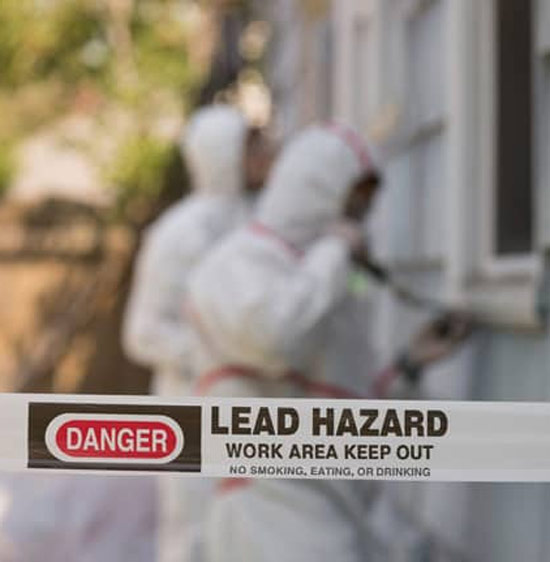Comprehensive Overview on Effective Lead Violation Elimination Techniques
In the realm of environmental safety and security, attending to lead violations requires a meticulous and organized technique. This comprehensive overview begins by highlighting the critical preliminary steps of recognizing lead risks via sophisticated assessment and testing methods. The guide elaborates on the value of adhering to rigid safety and security procedures throughout the removal procedure, including the usage of correct PPE and isolating influenced areas.
Recognizing Lead Threats
Recognizing lead risks is a crucial primary step in alleviating the risks linked with lead exposure. Lead, a poisonous metal, can be present in numerous ecological mediums, consisting of paint, soil, water, and dust. It poses extreme health dangers, specifically to children and expecting females, leading to neurological damages and developing delays. Precise identification of prospective lead resources is crucial for effective remediation.
The initial phase in identifying lead hazards involves understanding common lead resources within the constructed setting. Frameworks constructed prior to 1978 are especially prone because of the common use lead-based paint during that duration. Additionally, soil contamination can happen from deteriorating outside paint, commercial exhausts, or historical use leaded gas.
One more substantial source is lead piping and pipes components, which can leach introduce alcohol consumption water. Consumer goods such as playthings, ceramics, and imported products might likewise contain unsafe lead degrees. Especially, job-related settings and pastimes involving lead can track pollutants into homes.
Evaluation and Testing
When resolving lead risks, efficient analysis and testing are critical. This important step guarantees the recognition and metrology of lead visibility, thus leading succeeding remediation efforts. Preliminary analysis generally includes a visual assessment to recognize potential lead resources, such as degrading paint or infected dust. This is complemented by more strenuous screening techniques to identify the degree of contamination.

Dust clean tasting is one more important technique, particularly in domestic settings. By accumulating examples from floorings, windowsills, and other surface areas, this technique gives insights into potential exposure risks. In addition, soil testing around structure borders is vital to spot lead contamination that can pose risks, particularly to kids.
Safe Elimination Treatments
Upon completing comprehensive analysis and screening, executing risk-free removal procedures is the following vital stage in dealing with lead threats. This procedure makes certain that lead-contaminated materials are effectively and safely gotten rid of, decreasing risk to both employees and locals. The very first step entails separating the damaged location using plastic bed linen and appropriate securing techniques to stop the spread of lead dust.
Employees should don appropriate individual safety equipment (PPE), consisting of respirators, gloves, and non reusable her explanation coveralls, to reduce direct exposure. Employing specialized tools and damp techniques, such as damp fining sand or using HEPA-filtered vacuums, decreases the diffusion of lead bits. It is essential to avoid completely dry fining sand or unpleasant blasting, as these methods can generate dangerous lead dust.
Garbage disposal is an additional important part; all infected materials need to be firmly gotten and identified according to EPA and regional laws. Additionally, thorough cleaning of the workspace with HEPA vacuum cleaners and damp wiping ensures the elimination of recurring lead particles.
Post-Removal Verification

Verification of effective lead removal, understood as post-removal verification, is critical to make sure the safety and habitability of the remediated area. This inspection makes certain that all well-known resources of lead have been attended to and that no noticeable indications of contamination stay.
Following the visual examination, ecological tasting is performed. This involves gathering dust, soil, and in some cases water examples from the remediated area. click here to find out more Recognized research laboratories evaluate these examples to measure lead degrees, ensuring they fall below the safety and security thresholds developed by governing bodies such as the Epa (EPA)
Furthermore, air high quality testing may be executed to identify air-borne lead particles, especially in instances where comprehensive lead-based paint removal or improvement has actually taken place. The results of these tests provide quantitative data confirming that the lead levels are within allowable restrictions.
Ultimately, post-removal verification acts as a critical checkpoint, confirming the performance of the lead reduction initiatives and protecting the wellness of residents and visitors.
Safety Nets and Upkeep

An essential preventive measure consists of using lead-safe licensed professionals for any remodelling, repair service, or paint activities. These professionals are trained in techniques that lessen lead dirt and particles. Furthermore, keeping colored surfaces to avoid damaging or peeling off is important, as weakening paint can release lead fragments right into the setting.
Educational efforts targeting building owners and occupants pertaining to the dangers of lead and the value of reporting any type of potential risks can additionally improve preventative efforts. Regular cleansing making use of HEPA vacuums and wet wiping techniques can considerably decrease lead dirt build-up.
Conclusion
In recap, efficient lead offense elimination demands a precise technique incorporating thorough evaluation, exact testing, and rigorous removal procedures. Continuous assessments and maintenance are vital to alleviate future lead threats, therefore guarding public health and making sure sustained this post compliance with regulative needs.